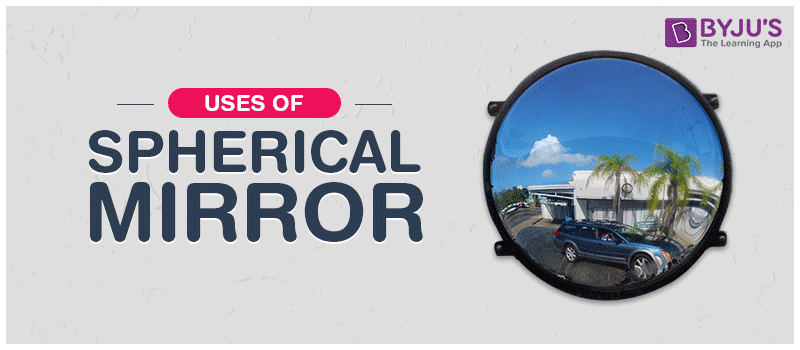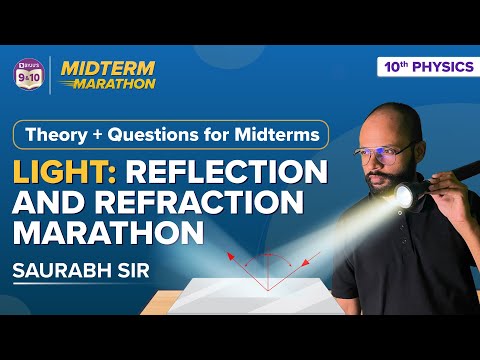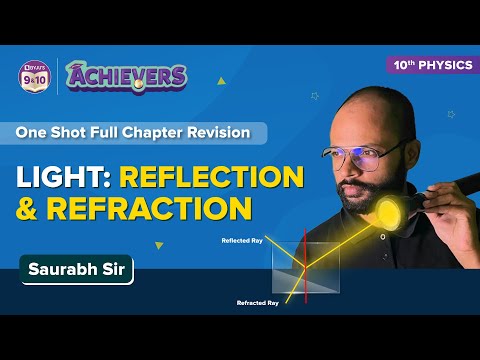A spherical mirror is a mirror that has the shape of a piece cut out of a spherical surface. There are two types of spherical mirrors: concave mirror and convex mirror. In this article, we will be studying the spherical mirror structure and its different types in detail.
|
Table of Contents: |
History of Spherical Mirrors in Human Civilization
- The first mirrors used by humans were most likely pools of water. The earliest known manufactured mirrors were polished stone pieces.
- Back in 500 AD, Chinese people began making mirrors with silver-mercury amalgams.
- Claudius Ptolemy conducted various experiments with curved polished iron mirrors.
Terminologies
There are a few basic terminologies that one needs to know while studying spherical mirrors, and they are:
-
Center of Curvature
The point in the centre of the mirror passes through the curve of the mirror and has the same tangent and curvature at that point.
-
Radius of Curvature
It’s the linear distance between the pole and the centre of curvature.
-
Principal Axis
The imaginary line passes through the optical centre and the centre of curvature of any lens or a spherical mirror.
-
Pole
The midpoint of the spherical mirror.
-
Aperture
An aperture of a mirror or lens is a point from which the reflection of light actually happens. It also gives the size of the mirror.
-
Principal Focus
Principal Focus can also be called Focal Point. It’s on the axis of a mirror or lens wherein rays of light parallel to the axis converge or appear to converge after reflection or refraction.
-
Focus
It’s any given point, where light rays parallel to the principal axis, will converge after getting reflected from the mirror.
Types of Spherical Mirrors

Spherical mirrors are of two types, and they are classified as follows:
- Concave Mirror
- Convex Mirror
Watch the video below to understand the spherical mirror

Concave Mirror
We know that a cut-out of a reflective sphere is a spherical mirror. If the reflective surface is on the side curved inwards, it is a concave mirror. Concave mirrors are commonly used as shaving mirrors or by dentists and even in telescopes. The reflected image is magnified but the field of view is limited. Concave mirrors are also called converging mirrors.

Convex Mirror
Similarly, if the reflective surface is curved outwards, it is a convex mirror. Convex mirrors are used extensively as part of car mirrors. Depending on the focal length, the reflected image is reduced in size but the field of view is more. This is very useful for drivers as the blind spots are drastically reduced. Convex mirrors are also called fish eye or diverging mirrors. You can recognize these mirrors easily as the outward bulge is quite evident most of the time.

The Structure of Spherical Mirrors
A spherical mirror is always part of a bigger virtual sphere. Imagine a line passing the centre of this sphere which touches the reflecting surface at its centre. This line is called the principal axis.
The point where the principal axis meets the reflective surface has been marked by a point A in the figure. Point A is the vertex which is the centre of the mirror.

The centre of the sphere, from which the spherical mirror has been cut, is marked by point C in the figure. This is the centre of curvature. The distance from the vertex to the centre of curvature is the radius of curvature, denoted by the length ‘R’ in the figure.
The point which lies midway between the vertex and the centre of curvature is the focal point, marked as ‘F’ in the figure. The length measured by ‘f’ in the figure is called the focal length of the mirror. It is the distance between the vertex and the focal point of the mirror.
Although the figure above is that of a concave mirror, the properties remain the same for convex mirrors as well. The difference between them is based on the way they reflect light rays. There are also non-spherical mirrors like parabolic reflectors. When and why do we use different kinds of mirrors?
Uses of Spherical Mirror

Below, we have listed various uses of the convex and concave mirrors in detail.
Uses of Convex Mirror
- Rearview mirror: The side view mirror of the car forms a small and erect image with the help of convex mirrors which help to see the way behind the car.

- Security mirrors in ATMs: Security mirrors are kept near the ATMs so that the bank customer can check whether somebody is behind them or not.
See the video below to learn about the reflection from the spherical mirror.

Uses of Concave Mirror
- Satellite Dishes: One of the most important uses of a concave mirror is satellite dishes. These are used to receive the weaker signals sent from the communication satellites and then amplify them. These signals strike the concave mirror in parallel rays and get reflected back. These reflected rays are concentrated at the focus of the mirror. The main purpose of this mirror is to gather weaker signals coming from large areas and concentrate them at one point.

- Headlights in a car: A powerful source of light is kept at the focus point of the concave mirror in a smaller space at the back of the headlight. Any light striking the mirror from the focus will get reflected parallel to the axis of the concave mirror.

- Shaving mirror: Another use of concave mirror is a shaving mirror. The image formed after the reflections of the concave mirrors is helpful for people while shaving.

- Dentist’s mirror: The concave mirror helps the dentist to focus light on the tooth to be examined.

You may also want to check out these topics given below!
Recommended Videos
Part 1 Revision of the chapter: Light Reflection and Refraction Class 10 – Reflection

Theory and important questions of the chapter Light: Reflection and Refraction

Frequently Asked Questions – FAQs
What is the radius of curvature?
What is the mid-point of spherical mirror also known as?
What are the types of spherical mirrors?
Which mirror is used in car mirrors?
Why concave mirrors are used by the dentists?
Important concepts in the chapter Light Reflection and Refraction Class 10

Previous year questions in the chapter Light Reflection and Refraction Class 10

Stay Tuned to BYJU’S to learn more about optics, with the help of CBSE notes and interactive videos.

Very helpful
Its very helpfull😅
Thnxx a lot for these notes«
It is very helpful to me. Thank you😊😊
Its very helpful thanks byjus
Thanks it’s good